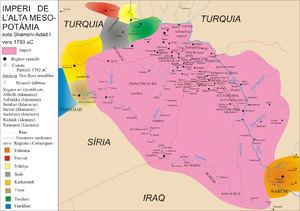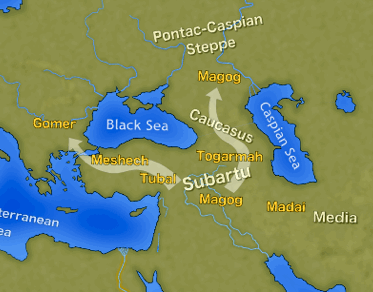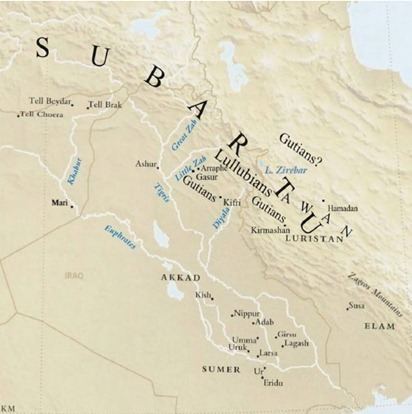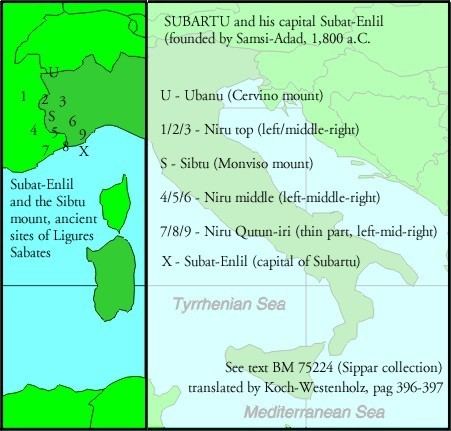Subartu
The land of Subartu (Akkadian Šubartum/Subartum/ina Šú-ba-ri, Assyrian mât Šubarri) or Subar (Sumerian Su-bir4/Subar/Šubur) is mentioned in Bronze Age literature. The name also appears as Subari in the Amarna letters, and, in the form Šbr, in Ugarit.
Contents
- Subartu
- Subartu mag g
- History
- Identity
- Amarna letters corpus
- The letters referencing region Subartu
- EA 108 Unheard of deeds
- References

Subartu was apparently a polity in Upper Mesopotamia, at the upper Tigris. Most scholars suggest that Subartu is an early name for Assyria proper on the Tigris and westward, although there are various other theories placing it sometimes a little farther to the east and/or north. Its precise location has not been identified. From the point of view of the Akkadian Empire, Subartu marked the northern geographical horizon, just as Mar.tu, Elam and Sumer marked "west", "east" and "south", respectively.

Subartu mag g
History

The Sumerian mythological epic Enmerkar and the Lord of Aratta lists the countries where the "languages are confused" as Subartu, Hamazi, Sumer, Uri-ki (Akkad), and the Martu land (the Amorites). Similarly, the earliest references to the "four quarters" by the kings of Akkad name Subartu as one of these quarters around Akkad, along with Martu, Elam, and Sumer. Subartu in the earliest texts seem to have been farming mountain dwellers, frequently raided for slaves.

Eannatum of Lagash was said to have smitten Subartu or Shubur, and it was listed as a province of the empire of Lugal-Anne-Mundu; in a later era Sargon of Akkad campaigned against Subar, and his grandson Naram-Sin listed Subar along with Armani, which has been identified with Aleppo, among the lands under his control. Ishbi-Erra of Isin and Hammurabi also claimed victories over Subar.

Three of the 14th century BC Amarna letters, Akkadian cuneiform correspondence found in Egypt, mention Subari as a toponym. All are addressed to Akhenaten; in two (EA 108 and 109), Rib-Hadda, king of Byblos, complains that Abdi-Ashirta, ruler of Amurru, had sold captives to Subari, while another (EA 100), from the city of Irqata, also alludes to having transferred captured goods to Subari.
There is also a mention of "Subartu" in the 8th century BC Poem of Erra (IV, 132), along with other lands that have harassed Babylonia. In Neo-Babylonian times (under Nabopolassar, Nebuchadnezzar II and Nabonidus).
Identity
Subartu may have been in the general sphere of influence of the Hurrians. There are various alternate theories associating the ancient Subartu with one or more modern cultures found in the region, including the Armenians or Kurds. The Kurdish scholar Mehrdad Izady, claims to have identified Subartu with the current Kurdish tribe of Zebari/Zubari/Zibaris inhabiting the northern ring north of Erbil, east of Mosul up to Hakkari in Turkey.
Amarna letters corpus
Subartu (Subaru of the letters) is a toponym mentioned in the Amarna letters (14th century BC); the letters were written in the short period approximately from 1350–1335 BC. It is commonly accepted that the region referenced was Subartu.
Subartu is only referenced in three of the Amarna letters: EA 100, 108, and EA 109. All three letters state that people, or 'items' are needed to be sold in Subaru, for money.
The letters referencing region Subartu
Subaru of the letters is only referenced in three Amarna letters, and with no links to any rulers of Subaru.
The following are the letters referencing Subartu:
EA 100—Title: "The city of Irqata to the king" -See Arqa, Amarna letters IrqataEA 108—Title: "Unheard-of deeds" -letter of Rib-HaddaEA 109—Title: "Then and now" -letter of Rib-Hadda